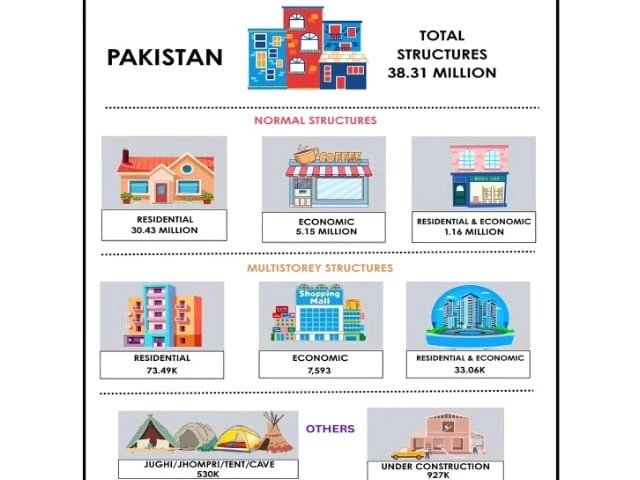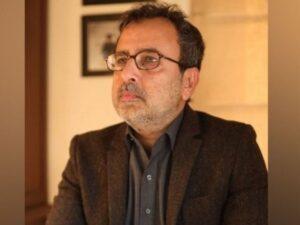Islamabad:
There are more than 600,000 mosques and 23,000 factories in Pakistan, while the service sector employs 45% of the total workforce, demysse the myth according to which industry is the main sector of creating the country, according to the conclusions of the very first economic census of Pakistan.
The economic census also revealed that out of a total of 40 million permanent units in Pakistan, there were about 7.2 million employment structures where 25.4 million people worked from 2023. The information had been obtained within the framework of the population census, but the report was officially published Thursday by the Minister for Planning Ahsan Iqbal. It was the third detailed report of this type launched by the Ministry of Planning after the population census and the census of agriculture, completing the missing parts that have embarrassed economic planning -based economic planning in Pakistan since 1947.
The report has shown that Punjab and Karachi division have the highest concentration of economic establishments and labor. He stressed that there were 600,000 mosques in Pakistan and more than 36,000 religious seminars, mainly in Punjab. However, there were only 23,000 factories in more than 643,000 small production units.
On a total workforce of 25.4 million, the largest proportion is engaged in the service sector, representing 45% or 11.3 million, depending on the report. This is followed by the social sector with 30% or 7.6 million workers. The production sector has only employed 22% of the total workforce, half the number of people working in the service sector.
Punjab has the largest labor, with 13.6 million workers, leading both in the production and services sectors. The Sindh follows with 5.7 million workers, Khyber-Pakhtunkhwa (KP) has 4 million workers and Balutchistan with a workforce of only 1.4 million.
The report has shown that most companies in Pakistan are on a small scale, employing a handful of people, in part because the service sector is considered cheaper. Up to 7.1 million economic structures employ between 1 and 50 people. The number of companies employing between 51 and 250 is only 35,351, while there are only 7,086 units that employ more than 250 people.
“Credible data is the backbone of sustainable development, as they allow planning based on evidence and effective decision -making,” said Iqbal when speaking during the launching ceremony. He stressed that even artificial intelligence cannot effectively work without reliable data, noting that in the digital economy, data is the real fuel stimulating growth. The report has also shown that out of 7.2 million registered establishments which have also been PK Press Club-marqués, the main classifications include 2.7 million retail stores, 188,000 wholesale stores, 256,000 hotels and 119,000 hospitals. There were also 242,000 schools, 11,568 colleges, 214 universities, 604,000 mosques and 19,645 banks. The country has 29,836 public offices and 10,452 semi-government offices.
The objectives of the economic census are to provide a complete and detailed image of the structure and characteristics of the economy and to collect information on the nature of the activity, size, employment and property of establishments. Iqbal noted that if neighboring countries have carried out regular economic censuses since 1977, Pakistan had been late. An attempt was made in 2003 but failed when questions related to the activity were added to the framework of the population census. India has carried out seven economic censuses, while Bangladesh, which separated from Pakistan in 1971, has so far carried out three.
Out of 7.2 million economic structures, around 3.2 million establishments reside in the category of wholesale and retail trade; Repair of motor vehicles and motorcycles. About 696,000 establishments belong to manufacturing, while the number of establishments involved in education amounts to 326,000. The majority of establishments in Pakistan are the service sector with 58%, followed by the production sector at 25%and the social sector at 14%. A small proportion of 3% is classified as “others”, indicating a limited activity outside these main sectors.
There is a total of 242,616 schools, mainly managed by the government, and 11,568 colleges, with a slightly higher share in the private sector. The country has 214 universities, 36,331 Madrassas and 119,789 hospitals, where private facilities constitute the majority. Overall, Punjab leads to public and private institutions. About 5.6 million households are engaged in a certain form of economic activity and more than half – 51.4% – are involved in animal farming, which makes it the most common activity. About 41% of households are engaged in various other unpertified or various activities. Some 3.9% of households are involved in sewing, while embroidery represents 1.4% and 1.3%. The smaller percentages are engaged in the packaging of food or preparation at home, beauty salons and online services, each contributing to less than 1%.
Most structures in Pakistan are in Punjab, which holds 58% of the total establishments. Sindh has 20%, followed by KP with 15%. Balutchistan represents 6%, while Islamabad has the smallest part with only 1%. This means that Punjab has the greatest number of structures. On the other hand, the relatively lower percentages for Balutchistan and Islamabad reflect their lower density of physical structures compared to other regions.
Residential structures constitute the largest share with 79.4% of the total buildings, which indicates a strong accent on housing. KP has the highest proportion of residential structures at 81.6%. Overall, Pakistan infrastructure is mainly residential, with less emphasis on buildings for mixed or purely economic use. The total number of several floors structures in Pakistan is 114,148, of which 64.4% are residential on several floors, 29% are residential for mixed and economic use, and 6.7% are purely economic structures. The Sindh represents the majority of residential structures on several floors.




